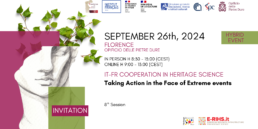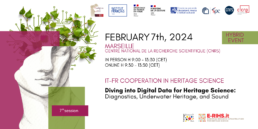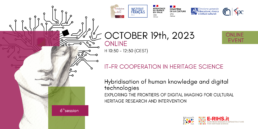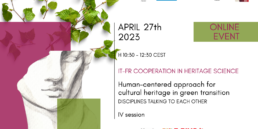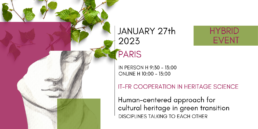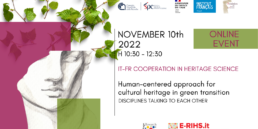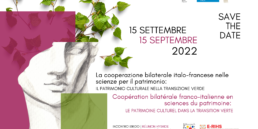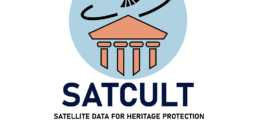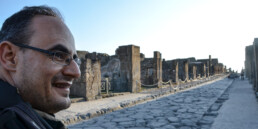IT-FR cooperation in Heritage Science
Human-centered approach for cultural heritage in the digital transition
Disciplines talking to each other
June 28th 2023 | Hybrid Event
In person: Naples, Suor Orsola Benincasa University | 9:00 AM - 1:30 PM (CEST)
Online: Teams platform | H 9:30 AM - 1:30 PM (CEST)
Within the framework of the Italian-French bilateral cooperation in Heritage Science, the fifth hybrid event will be focused on cultural heritage in digital transition.
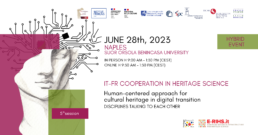
The hybrid event will take place on June 28th in presence at the Sala degli Angeli of the Università Suor Orsola Benincasa (Via Suor Orsola, 10, 80135 Napoli NA, Italia) from 9:00 am to 1:30pm (CEST) or online on Teams platform from 9:30 am to 1:30pm (CEST).
We are excited to bring together experts from different fields to discuss the current context of cultural heritage in the digital transition with the objective of providing insights from different disciplines and perspectives.
The organisation of the event has been coordinated by the Istituto di Scienze del Patrimonio Culturale del Consiglio Nazionale delle Ricerche, the French ministry of Culture, the Fondation des Sciences du Patrimoines, the Institut Français Italia, the French Embassy in Italy, the Direzione Generale Educazione, ricerca e istituti culturali of the Italian Ministry of Culture, the Università Suor Orsola Benincasa, the TICHE Foundation and the Université Franco-Italienne.
Registration is open!
To ease the organisation of the seminar and confirm your participation, you need to register for the event.
Please bear in mind that registration will be open until June 23rd.
We look forward to seeing you online on June 28th!
Presentations by speakers at the event are available here
Cultural heritage in digital transition
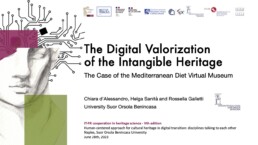
Chiara d'Alessandro, Helga Sanità and Rossella Galletti, University Suor Orsola Benincasa | Abstract
The Digital Valorization of the Intangible Heritage
The Case of the Mediterranean Diet Virtual Museum
Digitization of cultural heritage is an indispensable methodological practice for their preservation and valorization.
In the field of intangible cultural heritage, every heritage agency process is characterized by three elements: by the narrative that constructs the assets; by the need to inventory them, i.e., to file and catalog them in order to ensure the dissemination of their knowledge and their preservation; and by the protagonists of the heritage themselves, the stakeholders, i.e., the bearers and practitioners – as UNESCO defines them – who represent the communities that hold the assets and are themselves living heritages.
The Virtual Museum of the Mediterranean Diet was conceived and created by the anthropologists of MedEatResearch. It is a digital inventory tool of Mediterranean food cultures, where there are the most disparate witnesses, from the doctors who first codified the Mediterranean diet to the centenarians from Cilento who daily practice it, tell through video interviews the secrets of this intangible heritage of humanity.
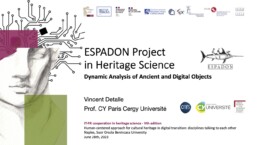
The ESPADON Project: the dynamic analysis of ancient and digital objects in Heritage Science
ESPADON aims to provide the community with new instrumental means for multi-scale 3D tomography and multi-physics 2D imaging, made possible by increased computational power. Additionally, it aims to offer unique digital resources and expertise for processing and managing massive data, in complementarity with the support of TGIR Human-Num and the ongoing actions of SoCoRe and Parcours.
ESPADON builds upon existing dynamics established since the launch of the first EquipEx PATRIMEX.
In the long term, this project will integrate the following elements:
- The establishment of a network of devices working at different scales and levels of mobility, allowing for on-site analysis of artworks when necessary.
- Shared management and utilization of data.
- The effective structuring, largely already demonstrated, of a network of researchers and laboratories across the territory, incorporating training elements for students and future researchers.
- The establishment of raw data archiving, as well as “finalized” data, enabling the creation of augmented heritage objects.
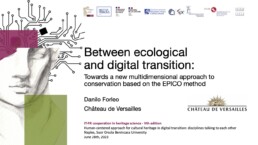
Between Ecological and Digital Transition: towards a new multidimensional approach to conservation based on the EPICO method
EPICO (European Protocol In Preventive Conservation) is a research program and evaluation method specifically designed for the preventive conservation of the collections in historic residences and castle-museums. This innovative method takes a systemic approach, establishing connections between the state of collections and decorations, environmental phenomena, and site management to determine diagnostics, preventive conservation actions, and the necessary resources for implementation.
Given the current context of climate change and economic crisis, preventive conservation has become an essential discipline to address the challenges of ecological and digital transition. This presentation introduces a new multidimensional approach to preventive conservation based on the EPICO method, aligned with the guidelines of the Ministry of Culture of France and the ESPADON project. One of the focal points of the new research program aims to enhance and promote this diagnostic method through the study and implementation of new digital and instrumental tools to address emerging ecological and digital challenges.
The objective is to consolidate and ensure the interoperability and transmission of information already generated with the EPICO method for the conservation of castle-museums, making it a reference in the field of preventive conservation. The technology transfer to a digital platform will expand the accessibility of the method and integrate local and international information derived from various multi-scale and multimodal measures within a unified platform, enabling a comprehensive vision and optimized preventive conservation.
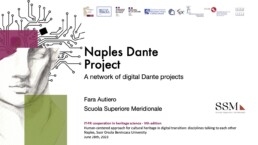
Naples Dante Project: a network of digital Dante projects
Naples Dante Project (NDP) is the new platform for Dante projects at the University of Naples Federico II. Its main aim is the investigation of the production of the Florentine poet through the integrated study of material, textual, iconic, and linguistic evidence.
One of the most important goals of the NDP is the extension of Illuminated Dante Project (IDP) to the digital review of the entire manuscript tradition of Dante’s Commedia (eCommedia). This ambitious development was preceded by an intermediate phase represented by the Fragments of Commedia (FraC) project, which is creating a digital archive and catalogue of all fragments of the direct tradition of the Divine Comedy, in collaboration with the Manus online and Fragmentarium platforms.
On the more specifically iconographic front, NDP is preparing to broaden the field of investigation of Dante illustrations from manuscripts to printed books and drawings (Illustrated Dante Project), starting from the 15th and 16th centuries. The talk aims to demonstrate the functionality of the Illuminated Dante Project database, which is the only one of the NDP projects currently online, highlighting the advantages of the IIIF protocol for the preservation of cultural heritage.

The PERCEIVE Project
Perceptive Enhanced Realities of Colored collEctions through Artificial Intelligence and Virtual Experiences
PERCEIVE aims at creating a new way to perceive, preserve, curate, exhibit, understand and access colored Cultural Heritage collections and Digital Artworks, promoting their re-appropriation. These collections are a priority because of their high fragility that requires shared methods to preserve and exhibit them, because of the complexity of their study and because of the significance of being able to properly communicate these to future generations. PERCEIVE supports the shaping of an European common identity around the concepts of care and diversity and at the same time strengthens the digital market for the creative industries.
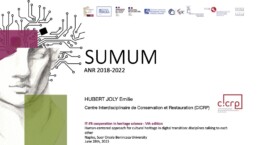
SUMUM Programme
New Acquisition and Processing Strategies for Digitising Heritage
When digitizing cultural heritage objects, the respect of their integrity is a basic principle. The study of their material and their interaction over time and the environment requires to limit sampling and the use of non-invasive means of observation. This is why the sciences and technologies of imaging capturing the form (3D) and more recently of the appearance play a leading role. The encounter between digital sciences and the needs in conservation of cultural heritage constitute for these sciences, new challenges and fields of validation, and for the actors of the heritage new forms of apprehension and opportunities of valorization.
The markers of the SUMUM project consist in the development and implementation of a multi-scale and multimodal approach adapted to the complexity of surface information and their appearance, driven as closely as possible by the needs and demands of end-users (monitoring of change, visualization, etc.) by proposing adapted acquisition strategies and shared processing tools adaptable to the wide variety of needs and demands of heritage actors.
SUMUM has proposed innovative strategies (on both instrumental and associated processing sides) for the digitization/modeling of heritage objects and the appearance of their surfaces in view of their conservation restoration.
Innovative strategies and systems of digitization of shape and appearance coupling different imaging modalities at different scales of observation have been imagined, developed and implemented. The exploitation of the resulting data shows their relevance with regard to the expectations of the stakeholders (conservation and restoration) because they allow a more shared and realistic apprehension and explorations of surfaces more progressive in terms of scale. Data from these approaches have been integrated and disseminated to experts and the general public.
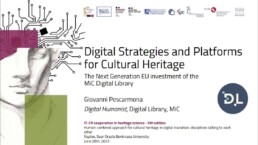
Digital Strategies and Platforms for Cultural Heritage: The Next Generation EU Investment of the MiC Digital Library
In this talk, the speaker briefly outlines the mission and the activities of the Central Institute for the Digitalisation of Cultural Heritage (ICDP) – Digital Library of the Italian Ministry of Culture (MiC), its institutional aims and goals, and the major challenges and opportunities of the Next Generation EU M1C3 1.1 Investment “DIGITAL STRATEGIES AND PLATFORMS FOR CULTURAL HERITAGE”. The investment, with a total budget of 500 million Euros, is part of the Italian National Recovery and Resilience Plan, and has the objective of creating a new digital cultural ecosystem, based on a cloud strategy and strong technical advancements.
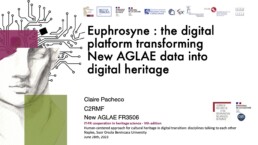
Euphrosyn: the digital platform transforming New AGLAE data into digital heritage
Integrating and sharing scientific data within the frameworks, norms and processes of Open Science should be considered as the alpha and the omega of any study of Cultural Heritage entity. As a matter of fact, if the property of a Cultural Heritage object is not always institutional, its cultural and spiritual dimension is intrinsically universal and belongs to anyone.
So, how should we consider the IBA data acquired on such specific targets? Are they part of the cultural heritage object which will then be digitally augmented? Are they part of a digital twin of the piece of art?
Hence, the mission of the New AGLAE team is to preserve and transfer the IBA data sets acquired on precious objects made of stones, glass, ceramics, metals, etc. and dating from Paleolithic to 21st c. to future generations as a piece of digital cultural heritage, starting by making the data respect the FAIR principles (Findable, Accessible, Interoperable, Reusable). The FAIR process is optimized along the IBA data life cycle, from the application for New AGLAE beam time to the perennial storage of data sets and the publication of data, through their processing and current storage.
Following this logic and also in order to improve the various uses of IBA data within the communities built around the New AGLAE, IBA for Cultural Heritage and more widely Heritage Science, the Euphrosyne project was conceived. Euphrosyne is not only Aglae’s sister in mythology, but it is also the name of the digital platform that is being developed with the Digital Workshop of the French Ministry of Culture to make the New AGLAE data FAIR.
Euphrosyne enables New AGLAE users to safely reach their data and to remotely process them with the software suite available at the facility.
Soon, the digital tool should enable interrogating, accessing and sharing IBA data respecting the FAIR principles.
Further information
The event is fifth of a series of seminars.
- The first event held in Rome on September 15th, 2022
- The second event held online on November 10th, 2023
- The third event held in Paris on January 27th, 2023
- The fourth event held online on April 27th, 2023
For further information about previous events, we invite you to visit the pages dedicated to the Italian-French partnership for heritage science.
